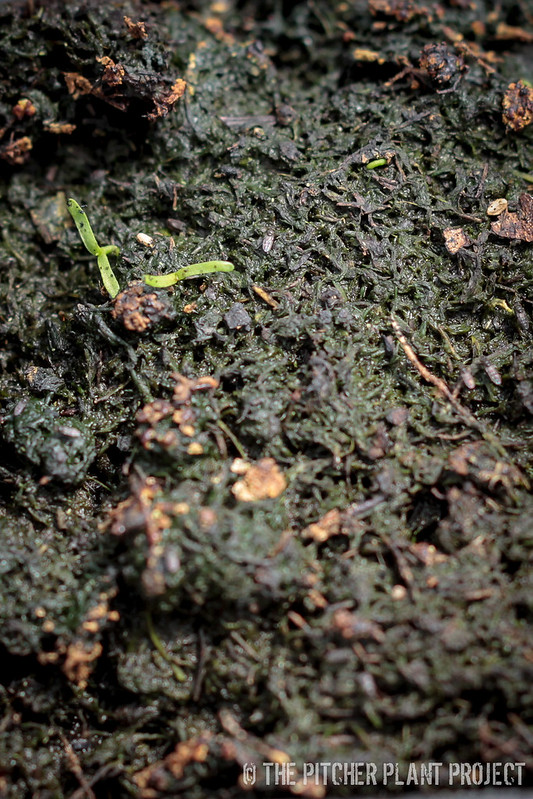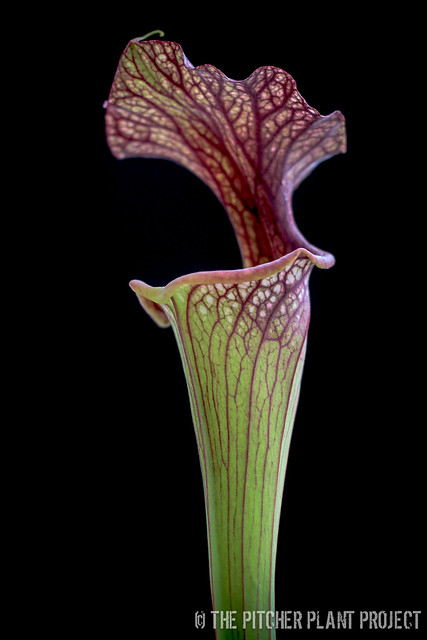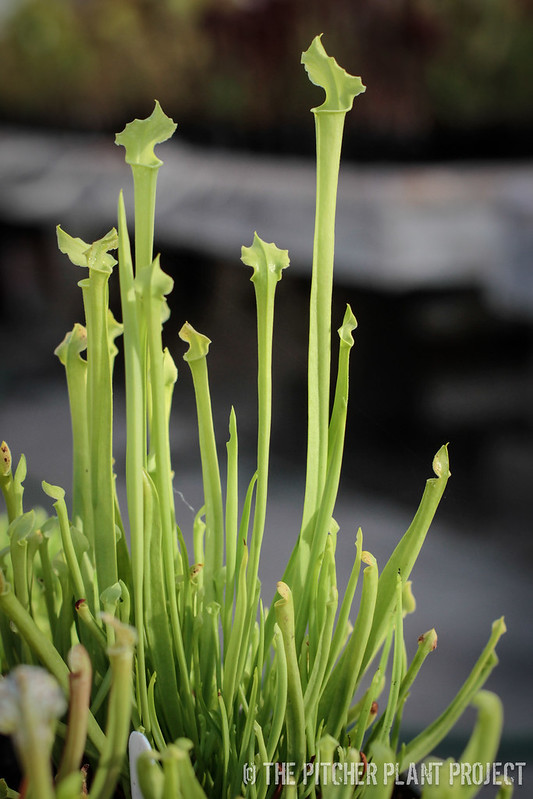In the last post, it seems that the plant I have shows off anthocyanin free qualities – without any red coloring. I mean, it’s *supposed* to be AF, right? After all, Brooks Garcia did this cross with anthocyanin free plants: Sarracenia purpurea ssp. purpurea f. heterophylla x (leucophylla AF x rubra ssp. jonesii AF). A photo of a few of his S. “Bog Goblins” are below.
![Bog Goblin]() Sarracenia “Bog Goblin”
Sarracenia “Bog Goblin”
Photo by Brooks Garcia
So here’s the weird thing: the plant I have *at initial glance* seems to be AF. New pitchers have no red markings whatsoever. As the pitchers age for me, it’s a different story. There seems to be a “leakage” of anthocyanin in this anthocyanin free plant. It could stem from a variety of reasons. Could it be my environmental conditions? Water? After all, I water my plants with tap. My tap water, thankfully is clean enough but it’s not as “pure” as I would like. My water runs anywhere from 50ppm-110ppm. The water company here adds chloromine (a chlorine/ammonia compound) to treat the water.
Here’s an interesting post on the International Carnivorous Plant Society Forums. In the thread, Phil Sheridan of Meadowview points out:
“Red blushing in floral or vegetative structures of anthocyanin-free plants is possible. A classic case was Don Schnell’s anthocyanin free Sarracenia jonesii which sometimes have a slight red hint in some leaf veins. Although all Sarracenia studied to date share the lesion in the same gene which blocks anthocyanin biosynthesis there is occasional “leakage” and anthocyanin may be produced in some plants. We don’t know why yet but perhaps enzyme activity is restored due to some factor and a small amount of pigment is produced.”
It could be that something or a combination of some things on my end triggers the enzyme activity that causes this “leak” in this particular clone. Or could it be that what we’re seeing is not really anthocyanin, but another pigment like betalain? (Ehhh maybe. Or maybe not. It is said that betalain occurs in other plant families, and probably not present in Sarracenia… who knows though.) For me, the red leakage has happened on very rare occasions and in a small quantities on other plants, like the AF S. jonesii mentioned above. Perhaps only two or three times that I can recall out of all the years I’ve been growing so far.
Anyway, check it out. These older pitchers exhibit some faint red coloration in the veins. Interesting stuff!
![Sarracenia "Bog Goblin"]()
Sarracenia “Bog Goblin”
Sarracenia purpurea ssp. purpurea f. heterophylla
x (leucophylla AF x rubra ssp. jonesii AF)
![Sarracenia "Bog Goblin"]()
Sarracenia “Bog Goblin”
Sarracenia purpurea ssp. purpurea f. heterophylla
x (leucophylla AF x rubra ssp. jonesii AF)
![Sarracenia "Bog Goblin"]() Sarracenia “Bog Goblin”
Sarracenia “Bog Goblin”
Sarracenia purpurea ssp. purpurea f. heterophylla
x (leucophylla AF x rubra ssp. jonesii AF)

 Sarracenia flava “Cinnamon Tube”
Sarracenia flava “Cinnamon Tube”









![Sarracenia [(rubra x oreophila) x flava var. rugelii] x 'Adrian Slack'](http://farm8.staticflickr.com/7307/8721269667_6332ddcf4d_z.jpg)




 When I came home just this recent Friday, I was excited to see a big ol’ box waiting for me. A box full of NEPENTHES! Yay! A HUGE thank you to Kinjie Coe for sending all of these wonderful gems. The plants arrived in great condition and I took the them to the greenhouse the next day. I spent my Saturday moving some plants around and potting up the new babies! Now, I’m still doing a lot of tinkering and experimenting with them and seeing how they’ll grow best in my area.
When I came home just this recent Friday, I was excited to see a big ol’ box waiting for me. A box full of NEPENTHES! Yay! A HUGE thank you to Kinjie Coe for sending all of these wonderful gems. The plants arrived in great condition and I took the them to the greenhouse the next day. I spent my Saturday moving some plants around and potting up the new babies! Now, I’m still doing a lot of tinkering and experimenting with them and seeing how they’ll grow best in my area. 
































